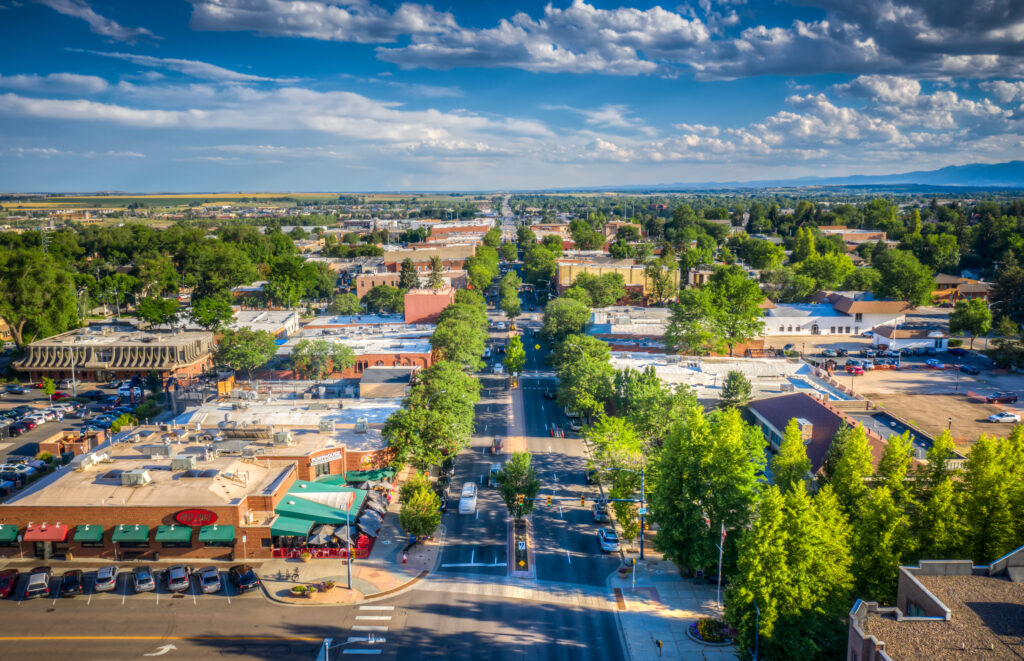
If you drive around downtown Longmont, you’re bound to see some spectacular historical homes. Established by the Chicago-Colorado Colony in 1871, Longmont still boasts a quaint, yet bustling, downtown lined with stunning brick buildings, some of which have stood for over a hundred years.
Main Street divides the town into two historic districts: East Side and West Side. South of Longs Peak Avenue, the East Side Historic District contains 67 historic houses, whereas the West Side Historic District contains 118. These beautiful and significant neighborhoods were added to the National Register of Historic Places in 1986 and 1987, respectively.
With the aid of the plentiful historical resources that the city of Longmont has to offer, consider taking a tour of our classic homes. We’ve listed a handful below that caught our eye, take a gander at this more detailed list of designated landmarks put together with the aim of historic preservation.
East Side Historic District:
This is considered to be the older of the two districts, established when the Chicago-Colorado Colony took root. Built mostly in the 19th century, Queen Anne-style homes rule here. “Queen Anne homes are asymmetrical, with highly ornamented facades and more than one story. The Queen Anne style is all about decorative excess, with a variety of surface textures and materials like patterned brick, stone, wood, and occasionally stucco,” writes Realtor.com.
The East Side Historic District extends from 4th Avenue north to 8th, and from Kimbark St. east to Atwood.
Some of the prominent historical homes in the East Side Historic District:
- Albert Benson’s house was built at 444 Collyer Street in 1872. It’s one of the earliest residences in Longmont and Collyer Street was named for Robert Collyer, who was the first president of the Chicago-Colorado Colony.
- George Atwood, a successful merchant, built his Edwardian-style home on Collyer Street as well. Constructed in 1883, it was called the Atwood-Jones House.
- The founder of Mead, Colorado, Lorin C. Mead, built his Victorian home, the Mead House, on Collyer, also in 1883
- In the same year on Emery Street, James Parker Warner, a mortician, and furniture store owner built his “two-story wood-frame home…[which] reflected the vernacular architecture of early Longmont,” according to the Colorado Encyclopedia.
- James Wiggins also built his “classic cottage house” on Emery, but in 1902. A famed local craftsman, he also built the Callahan House on Terry Street (in the West Side Historic District) in 1892.
- The Webb House was built on 536 Collyer Street in 1888. It has been renovated twice, in 1937 and 1980. The owners who conducted the 1980 expansion kept the design close to the home’s original Victorian style. The renovation was even featured in Victorian Homes magazine.
Prominent Longmont residents, like the Atwoods and the Warners, started moving from the east side to the west side once Longmont’s sugar beet factory opened and the wealth began shifting west.
West Side Historic District:
As Longmont grew and agriculture boomed, people began building houses on the west side that were larger, post-Victorian-style homes on bigger lots. As stated by the Colorado Encyclopedia, “Architecturally, most of the houses in Longmont’s West Side Historic District can be categorized as Edwardian Vernacular (a later version of the Queen Anne design) or American Foursquare (square-planned, two-story residences topped with a hip roof).”
Longmont’s West Side Historic District exists roughly from 3rd Avenue to 9th, and from Main Street west to Bowen.
A few well-known west side homes.:
- Jarvis M. Fox, known for building Longmont’s first flour mill, built a home in 1895 at 920 Third Avenue. The Fox-Downer house represents the Edwardian Vernacular style and its large size demonstrates the wealth that agriculture brought to Longmont. The house has a simple, unadorned exterior, in contrast to the frivolity of the Queen Anne-era homes.
- The Atwood-Buckingham-Warner House, located at 311 Terry Street, was built in 1873, by W. J. Atwood, an early leader in Longmont. The residence was built in the Queen Anne style, but with Gothic and Italianate touches. The gorgeous home is now called The Terry Guesthouse, a wedding venue affiliated with another enchanting downtown building, The St Vrain.
- One of Longmont’s oldest buildings on the west side, the Library Hall at 335 Pratt Street, was built in 1871 and served as the first public library in Colorado. Built by Mrs. Elizabeth Thompson in a Cape Cod style, it originally had a vestibule and belfry with a bell.
- The Callahan House was built in 1892 at 312 Terry Street by the aforementioned James Wiggins. A feat in craftsmanship and woodwork, it boasts “white mahogany in the parlor, golden oak in the music room, Antwerp oak in the dining room, and San Domingo mahogany in Mr. Callahan’s office. The dining room table and sideboards were made especially…”
- In 1900, Dennis Charles Donovan, owner of D.C. Donovan Lumber Company, built an American Foursquare-style home at 347 Pratt Street. The two-story, brick home has a wide, inviting front porch and a simple outline in response to the more detailed and garish designs prevalent during the Victorian era.
Exploring Longmont’s Historic Districts: Landmarks, Landscapes, and Legacy Homes
If you’d like to see all of the registered historical buildings in Longmont, head to Longmont’s list of designated landmarks and our other informative references and resources below. Then grab a picnic lunch or pick one of Longmont’s best patios and head out on a walking tour of the historic district!
Want to scoop up your own historical home? We’re Longmont’s real estate experts who have been in the real estate business for decades, and we’d love to help you snag your own piece of Longmont history. When you are ready to look for homes for sale in Longmont, CO, give Turner Realty a call at 303-776-1105 or use our contact form!
Longmont History References and Resources:
There’s plenty of available information about historical landmarks in Longmont. Here are a few helpful sites:
https://www.timescall.com/2012/03/21/longmont-area-locations-carry-history-in-their-names/
https://www.realtor.com/advice/buy/queen-anne-victorian/
